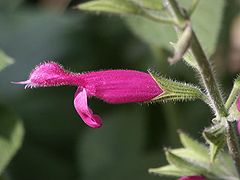Salvia dorisiana: Difference between revisions
Jump to navigation
Jump to search
No edit summary |
No edit summary |
||
| Line 5: | Line 5: | ||
|common_name=Fruit-scented sage, Peach sage | |common_name=Fruit-scented sage, Peach sage | ||
|name_ref=Flora - A Gardener's Encyclopedia | |name_ref=Flora - A Gardener's Encyclopedia | ||
|habit=herbaceous | |||
|habit_ref=Flora - A Gardener's Encyclopedia | |||
|Min ht box=36 | |Min ht box=36 | ||
|Min ht metric=in | |Min ht metric=in | ||
| Line 25: | Line 27: | ||
|image_width=240 | |image_width=240 | ||
}} | }} | ||
'''''Salvia dorisiana''''', '''Fruit-scented sage''' or '''Peach sage''', is a perennial shrub native to Honduras. It grows 1-1. | '''''Salvia dorisiana''''', '''Fruit-scented sage''' or '''Peach sage''', is a perennial shrub native to Honduras. It grows 1-1.3 m tall, and is heavily branched. The leaves have a fruity scent when brushed, and large magenta-pink flowers that bloom in winter. ''Salvia dorisiana'' was first described in 1950, and has become popular as a greenhouse plant. The flowers reach up to 5 cm in length, with a lime-green calyx about the same length. The entire plant is covered in hairs whose glands release a pineapple-grapefruit scent.<ref name="Clebsch">{{cite book|last=Clebsch|first=Betsy|coauthors=Carol D. Barner|title=The New Book of Salvias|publisher=Timber Press|date=2003|page=112|isbn=9780881925609|url=http://books.google.com/books?id=NM0iwB8GrQYC&pg=PA112}}</ref> | ||
''Salvia dorisiana'' was apparently named after [[Doris (mythology)|Doris]], daughter of [[Oceanus]] and [[Tethys (mythology)|Tethys]], and the wife of [[Nereus]]. She was mother to the fifty [[Nereids]].<ref name="Clebsch"/> | ''Salvia dorisiana'' was apparently named after [[Doris (mythology)|Doris]], daughter of [[Oceanus]] and [[Tethys (mythology)|Tethys]], and the wife of [[Nereus]]. She was mother to the fifty [[Nereids]].<ref name="Clebsch"/> | ||
Latest revision as of 08:11, 10 May 2010
| Salvia dorisiana subsp. var. | Fruit-scented sage, Peach sage | |||||||||||||||||||||||||||||||||||||||||||||||||||||||
|---|---|---|---|---|---|---|---|---|---|---|---|---|---|---|---|---|---|---|---|---|---|---|---|---|---|---|---|---|---|---|---|---|---|---|---|---|---|---|---|---|---|---|---|---|---|---|---|---|---|---|---|---|---|---|---|---|

|
|
| ||||||||||||||||||||||||||||||||||||||||||||||||||||||
| ||||||||||||||||||||||||||||||||||||||||||||||||||||||||
Salvia dorisiana, Fruit-scented sage or Peach sage, is a perennial shrub native to Honduras. It grows 1-1.3 m tall, and is heavily branched. The leaves have a fruity scent when brushed, and large magenta-pink flowers that bloom in winter. Salvia dorisiana was first described in 1950, and has become popular as a greenhouse plant. The flowers reach up to 5 cm in length, with a lime-green calyx about the same length. The entire plant is covered in hairs whose glands release a pineapple-grapefruit scent.[1]
Salvia dorisiana was apparently named after Doris, daughter of Oceanus and Tethys, and the wife of Nereus. She was mother to the fifty Nereids.[1]
Cultivation
Propagation
Pests and diseases
Varieties
Gallery
-
photo 1
-
photo 2
-
photo 3
References
- ↑ 1.0 1.1 Clebsch, Betsy; Carol D. Barner (2003). The New Book of Salvias. Timber Press. p. 112. ISBN 9780881925609. http://books.google.com/books?id=NM0iwB8GrQYC&pg=PA112.
External links
- w:Salvia dorisiana. Some of the material on this page may be from Wikipedia, under the Creative Commons license.
- Salvia dorisiana QR Code (Size 50, 100, 200, 500)
